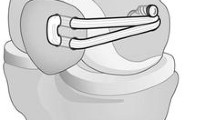Abstract
Background
Many studies have shown that injury to the popliteus tendon has little consequence for the static stability of the knee following total knee arthroplasty (TKA). However, very few studies have evaluated the effect of intraoperative iatrogenic popliteus tendon injury on the patient-reported outcome measures (PROMs) following TKA. This study aimed to determine the incidence of iatrogenic popliteus tendon injury in our subset of the population and to find out its effect on PROMs.
Methods
100 consecutive osteoarthritic varus knees with flexion deformities less than 20° were operated upon by a single senior experienced arthroplasty surgeon. Patients were assessed intraoperatively for any iatrogenic popliteus tendon injury, the injury site, and the amount of injury which was quantified and graded. PROMs applied for assessment at 1-year follow-up were Knee Society Score (KSS 1), Knee Function Score (KSS 2), and Western Ontario and McMaster University Osteoarthritis Index (WOMAC).
Results
17% of cases had an iatrogenic popliteus tendon injury. Thirteen had grade II injuries, whereas four had grade III injuries. There was no statistical significance in post-operative knee mobility and PROMs among those with popliteus tendon injury versus non-injured patients.
Conclusion
The incidence of iatrogenic popliteus tendon injury is higher than what we expected. The tendon injury remains a risk, but it is unclear how the popliteus tendon injury will affect patients after the TKA. In our series, such an injury during knee replacement does not affect the functioning of the knee in the short term; however, a long-term follow-up is warranted.

Similar content being viewed by others
References
Jung, G. H., Kim, J. D., & Kim, H. (2010). Location and classification of popliteus tendon’s origin: Cadaveric study. Archives of Orthopaedic and Trauma Surgery, 130, 1027–1032.
Aki, T., Sugita, T., Takahashi, A., Aizawa, T., Kamimura, M., Sasaki, A., Miyatake, N., & Itoi, E. (2017). Femoral footprint of the popliteus tendon may be at the risk of damage during total knee arthroplasty. Knee Surgery, Sports Traumatology, Arthroscopy, 25(12), 3718–3722.
Basmajian, J. V., & Lovejoy, J. F. (1971). Functions of the popliteus muscle in man. A multifactorial electromyographic study. Journal of Bone and Joint Surgery, 53(3), 557–562.
Ferrari, D. A., Wilson, D. R., & Hayes, W. C. (2003). The effect of release of the popliteus and quadriceps force on rotation of the knee. Clinical Orthopaedics and Related Research, 412, 225–233.
Kanamiya, T., Whiteside, L. A., Nakamura, T., Mihalko, W. M., Steiger, J., & Naito, M. (2002). Ranawat Award paper. Effect of selective lateral ligament release on stability in knee arthroplasty. Clinical Orthopaedics and Related Research, 2, 24–31.
De Simone, V., Demey, G., Magnussen, R. A., Lustig, S., Servien, E., & Neyret, P. (2012). Iatrogenic popliteus tendon injury during total knee arthroplasty results in decreased knee function two to three years postoperatively. International Orthopaedics, 36(10), 2061–2065.
Ammar, A., Abcha, O., Jaafar, S. B., Beriri, M., Smida, M., & Daghfous, M. S. (2021). Iatrogenic injuries of the popliteus tendon during total knee arthroplasty. EAS Journal of Orthopaedic and Physiotherapy, 3(4), 31–35.
Apinyankul, R., Sae-Jung, S., & Phruetthiphat, O. A. (2020). Increasing posterior condyle cut for high-flex knee prosthesis may injure popliteus tendon origin: A comparison between real clinical setting and cadaveric study. Journal of Orthopaedics, 22, 194–197.
Takahashi, A., Sugita, T., Aizawa, T., Chiba, D., Kamimura, M., Aki, T., & Itoi, E. (2015). Potential risk of excising the femoral insertion of the popliteus tendon during primary total knee arthroplasty: A biometric study. Journal of Orthopaedic Science, 20, 1030–1035.
Ghosh, K. M., Hunt, N., Blain, A., Athwal, K. K., Longstaff, L., Amis, A. A., & Deehan, D. J. (2015). Isolated popliteus tendon injury does not lead to abnormal laxity in posterior-stabilised total knee arthroplasty. Knee Surgery, Sports Traumatology, Arthroscopy, 23(6), 1763–1769.
Athwal, K. K., Daou, H. E., Lord, B., Davies, A. J., Manning, W., Baena, F. R. Y., Deehan, D. J., & Amis, A. A. (2017). Lateral soft-tissue structures contribute to cruciate-retaining total knee arthroplasty stability. Journal of Orthopaedic Research., 35(9), 1902–1909.
Cottino, U., Bruzzone, M., Rosso, F., Dettoni, F., Bonasia, D. E., & Rossi, R. (2015). The role of the popliteus tendon in total knee arthroplasty: A cadaveric study. Joints., 3(1), 15–19.
Kesman, T. J., Kaufman, K. R., & Trousdale, R. T. (2011). Popliteus tendon resection during total knee arthroplasty: An observational report. Clinical Orthopaedics and Related Research, 469, 76–81.
Tantavisut, S., Tanavalee, A., Ngarmukos, S., Limtrakul, A., Wilairatana, V., & Wangroongsub, Y. (2012). Gap changes after popliteus tendon resection in PS-TKA: A cadaveric study in Thai female knees. The Knee, 19, 597–600.
Funding
The authors did not receive any grants/funds to conduct the study.
Author information
Authors and Affiliations
Corresponding author
Ethics declarations
Conflict of interest
The authors have no conflict of interest to declare.
Ethical approval
Approval was granted by the Institutional ethics committee of Medica Superspecialty Hospital vide reference number CREC/2022/1(vi).
Informed consent
All procedures followed were in accordance with the ethical standards of the responsible committee on human experimentation (institutional and national) and with the Helsinki Declaration of 1975, as revised in 2008. Informed consent was obtained from all patients to be included in the study.
Additional information
Publisher's Note
Springer Nature remains neutral with regard to jurisdictional claims in published maps and institutional affiliations.
Rights and permissions
Springer Nature or its licensor (e.g. a society or other partner) holds exclusive rights to this article under a publishing agreement with the author(s) or other rightsholder(s); author self-archiving of the accepted manuscript version of this article is solely governed by the terms of such publishing agreement and applicable law.
About this article
Cite this article
Kapoor, V., Raj, A., Chatterjee, A. et al. Is Popliteus Tendon a Redundant Structure in Total Knee Arthroplasty?. JOIO (2024). https://doi.org/10.1007/s43465-024-01173-9
Received:
Accepted:
Published:
DOI: https://doi.org/10.1007/s43465-024-01173-9




